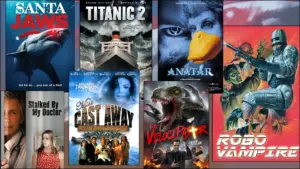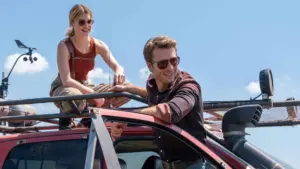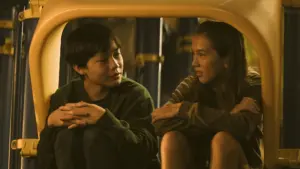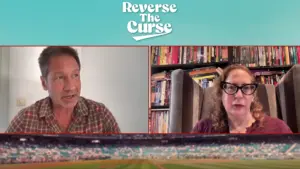Leave the World Behind, the Netflix-streamed adaptation of Rumaan Alam’s 2020 novel, is a provocative, conceptually rich disaster-suspense movie that annoyed the hell out of me. Produced by Higher Ground, Barack and Michelle Obama’s media venture, the story functions both as a plausible national-attack scenario and a compelling metaphor for the malaise of America’s collective unconscious. Everyone involved, starting with the auteur-level efforts of director Sam Esmail, brought their “A” game. Then they didn’t stop, and brought the rest of the alphabet along with it.
The movie begins with spouses Amanda (Julia Roberts) and Clay (Ethan Hawke) in a sunny Brooklyn bedroom, Clay waking groggily while Amanda paces around filling luggage. She’s set up an impromptu vacation, starting that day at an Airbnb house in Long Island. Clay, as malleable as his name suggests, agrees but asks why. With bada-bing nonchalance, Amanda explains that she was looking out the window at the busy city and realized, “I fucking hate people.”
Misanthropic whimsy gives way to a breezy opening scene with the couple and their two kids (high-school-age Archie and just-13 Rose) arriving at a picture-perfect, upscale house in a woodsy area of the Hamptons. As the camera swoops right-side-up and glides through the modern interior and up the stairs, Roberts’s character finds her happy place, jumping gleefully into a king-sized bed with large ocean waves painted on the wall behind her.
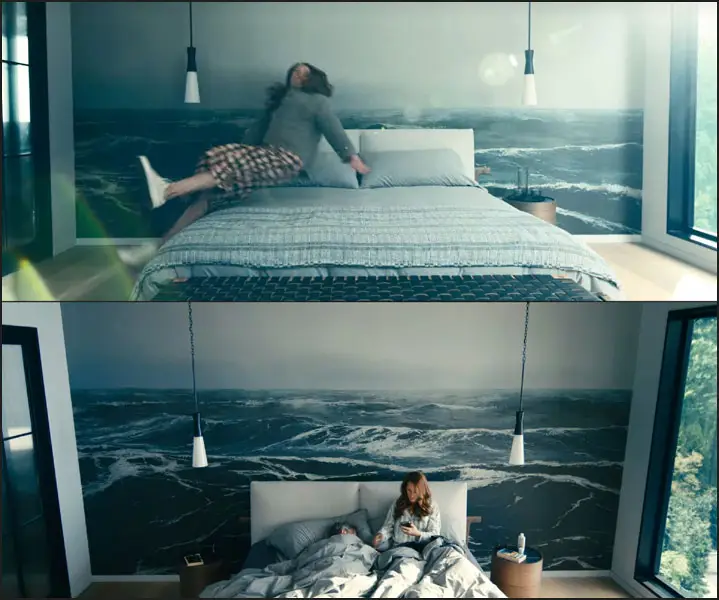
Those starting scenes, from one bedroom to another, indicate a story about interior feelings of comfort and safety, and Leave the World Behind‘s first act plays out like a shifting psychological art film. Esmail and production designer Anastasia White drop visual clues like gourmet croutons, starting with a large crack on a blue wall, and later with an abstract painting whose diffuse patterns transform over the course of the story. Ocean waves on the bedroom wall decoration inexplicably rise, and props are given the same saturated-blue “pop” while other colors are muted.
A beach outing introduces the first of several metaphors: An oil tanker on the distant horizon, drifting directly at the family as they lounge in comfort, assuming the ship will stop. Allegorically it seems to embody any encroaching modern disaster, fully in public view but ignored until it’s right upon us, then forgotten in the wake of whatever news panic comes next. The family flees harm just as the apparently unmanned tanker slams into the beach. After getting only a cursory explanation from an official ushering people away, the family drives back to their rental and Amanda says, “Look, a Starbucks.” The sequence could be a potent short film unto itself. (Incidentally, the ship’s name is “White Lion,” which according an online search symbolizes “the consciousness” and is a “messenger of the divine.”)
The film further pokes pins in the comfort zone when two strangers show up at night, asking to be let in. They’re George (Mahershala Ali) and Ruth Washington (Myha’la), a father and daughter who claim to be the house’s owners. Amanda is suspicious of their nervous explanation about seeking respite from a New York City blackout. Her trepidation is understandable, as the situation could open any number of horror movies, from Funny Games to Human Centipede, the potential for violent developments further hinted by an isolated shed in the woods. In an alternative universe this might unfold into an Ethan Hawke/Julia Roberts shockfest called Reality Bites Mystic Pizza.
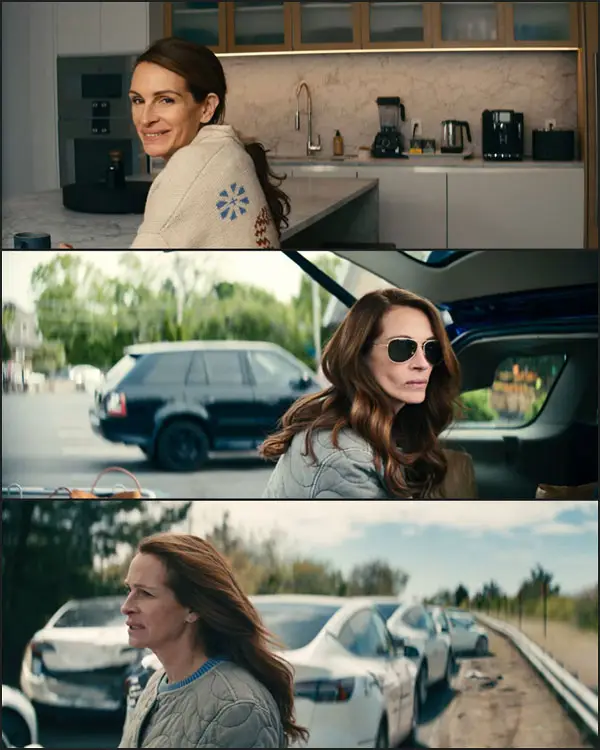
The late-arriving duo clearly are scared and holding something back. They are also African-American, and the story forces the issue of Amanda’s distrust being bigotry motivated. Symbolic racial tension is emphasized by Faith Ringgold’s “United States of Attica” (1972) artwork on the wall of the basement where the black duo agree to sleep (in spite of being the home’s owners), their lower place in the ethnic hierarchy stressed with bravura through-the-floors camera tracking to the white family sleeping at the upper level.
Such savvy details bring a sense of import to the mysterious proceedings, but the technique far outpaces the storytelling. What should register subconsciously becomes overt, with compositions too-frequently emphasizing space behind a character’s head, or staging people with their backs to each other. We get it: Anxiety and disconnection are outweighing social harmony. Even America’s Original Sin gets a nod when the number 1619 (the year of the first slave ship) shows up on a car’s AM radio. At least those touches mean something; there’s less excuse for cinematographer’s Tod Campbell’s onslaught of showy camera moves, which at one point include a bird’s-eye zoom straight up the rusty hole of a storage shed, just…because?
Leave the World Behind overflows with ideas and exposition, and it seems nobody (including furiously cross-cutting but rarely fat-trimming editor Lisa Lassek) wanted to leave (sorry) anything behind. Ancient clocks on the wall are contrasted with modern watches (complete with ticking-rhythm suspense music), linking the sense of a doomsday countdown to America’s historical continuum. Director Sam Esmail is best known for helming Mr. Robot, which built its first season around a Fight Club twist, and here he’s similarly eager to mimic his influences. That includes Alfred Hitchcock’s Nature-is-angry-at-us dread of The Birds, the freakish running-from-a-plane image from North by Northwest, and the Sword of Damocles-like framing of overhead chandeliers in Notorious. Other scenes recall the enigmatic beachside devastation of TV’s Lost series, the paranoia-rejecting choice near the end of War of the Worlds, an upsetting dash of David Cronenberg-like disease gore, the clinical pinned-butterfly framing of director Wes Anderson, and the umpteenth Mexican Standoff — that tropiest of tropes that needs to go away for good.
The movie also affects the reluctant tone of HBO’s White Lotus, where people of means know something’s not right but keep slipping back into their repression bubble, eking leisurely moments from their final holiday before the overconnected world falls to dust. Leave the World Behind feels like an inverse of the disaster movie Miracle Mile, where instead of a panicking Chicken Little who could turn out to be wrong, the characters are Chicken Biggles who deny the sky is falling even as they keep stumbling over chunks of it.
It’s easy to see why the novel was chosen by the Obamas’ production company, given its ambitiously overstuffed polemic, and the complexity of its warnings about polarization leaving the United States vulnerable to exploitation from the outside. Similar to Don’t Look Up, the movie is highly effective at building dread in a real-world setting that doesn’t let us off the hook easily. It even goes into Neil Postman-like “Amusing Ourselves to Death” media-critique territory, a character mentioning how “media serves as both an escape and a reflection,” as well as striking an ironic note with a sub-plot about the daughter’s fixation on Friends, a TV show “nostalgic for a time that never existed.”
Alas, where Don’t Look Up is piercingly sharp, Leave the World Behind turns into 2 hours, 21 minutes of Show me don’t tell me, Preaching to the converted, Overplaying its hand, and Too-on-the-nose dialogue. Characters split apart, pair off, see something upsetting, return to the rental house, avoid sharing their disturbing observations, then, scenes later, haltingly describe what we’ve already viewed. Repeatedly. Exhaustingly.
Its themes become built-in excuses for its flaws. Low-budget, “Where Is Everybody?” Twilight Zone emptiness? “That’s the point: post-Covid-lockdown life is insular.” Why doesn’t the family have a game plan? “That’s the point: modern society is dysfunctional.” Why lounge around drinking, vaping, dancing, and flirting? “That’s the point: they’re in denial.” Hawke’s character abandons a distressed Spanish-speaking woman in the road, later shamefully confessing the incident…why, then, does the movie drop that thread altogether? “That’s the point: Latinos are an afterthought in America.”
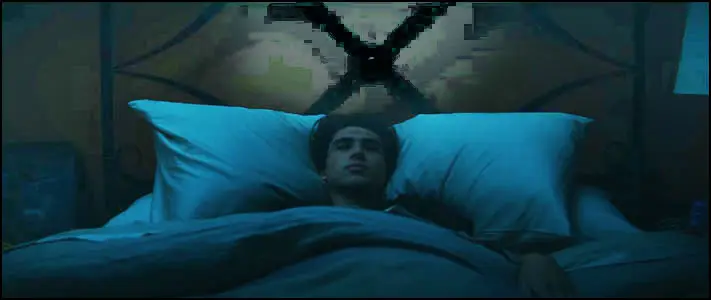
If only the characters had been more sympathetic or likable. The older son, Archie (Charlie Evans) is bad-karma-invitingly cruel to sister Rose (Farrah Mackenzie), whose iris-halving eyelids and haunted gaze recall the semi-grotesque girl in Ari Aster’s Hereditary. Somehow the media-fixated Rose hasn’t heard of bunny-ears antenna even though she can quote Aaron Sorkin’s West Wing at length. As Ruth, Myha’la comes across with an overwrought, 24-going-on-42 jadedness that makes her seem unduly bitter. Julia Roberts’s natural whoop-and-laugh charm feels sand-blasted by time, evoking a Spy vs. Spy figure played by Karen Black. Roberts’s misanthrope eventually gets some pro-human grace notes in an exchange with Myha’la, but they’re unearned by the story, and Myha’la has to deliver this real clunker: “I’m not down with most of the things you do and say, but this is the part of the Venn diagram where we overlap. I agree with everything you just said. But as awful as people might be, nothing’s gonna change the fact that we are all we’ve got.” Again: Show it, don’t tell it.
Smoothest in the cast is Mahershala Ali, as the sharp-dressed homeowner who wearily discloses insider knowledge of why civilization might be falling apart. Ali is an understated actor with a convincingly thoughtful stillness, and he holds his own in a three-way showdown opposite whiskery Ethan Hawke and crusty Kevin Bacon, the latter of whom gives his drawl-ey all to his brief role as a neighbor, a resource-hoarding conspiracy prepper with everything but the MAGA hat. Sorry to say, Ali too gets pulled into the movie’s illogical vortex. Scouting alone, he fails to notice beach carnage in every direction while finding something small in the sand, then returns home to characters questioning “Why are you wet?” even though (1) he doesn’t look wet, and (2) there’s no further justification for him not fully freaking out.
Finally, after an excess of churning build-up, the movie’s final act turns exasperatingly silly, with characters screaming and waving their arms at migrating CGI deer, self-driven Teslas plowing into each other like Elon Musk letting off steam during a ketamine binge, flamingos dropping by the pool on their way to a happier production (one hopes), unexplained Havana syndrome-like sonic attacks, and a series of chamber-play style monologues featuring terms such as “mass delusion” and “free-range chicken.” Director Sam Esmail’s kitchen-sink approach lodges half-way between scrupulous The Shining and schlocky The Happening, with the result that Leave the World Behind feels like an all-in-one allegory in search of a movie.







